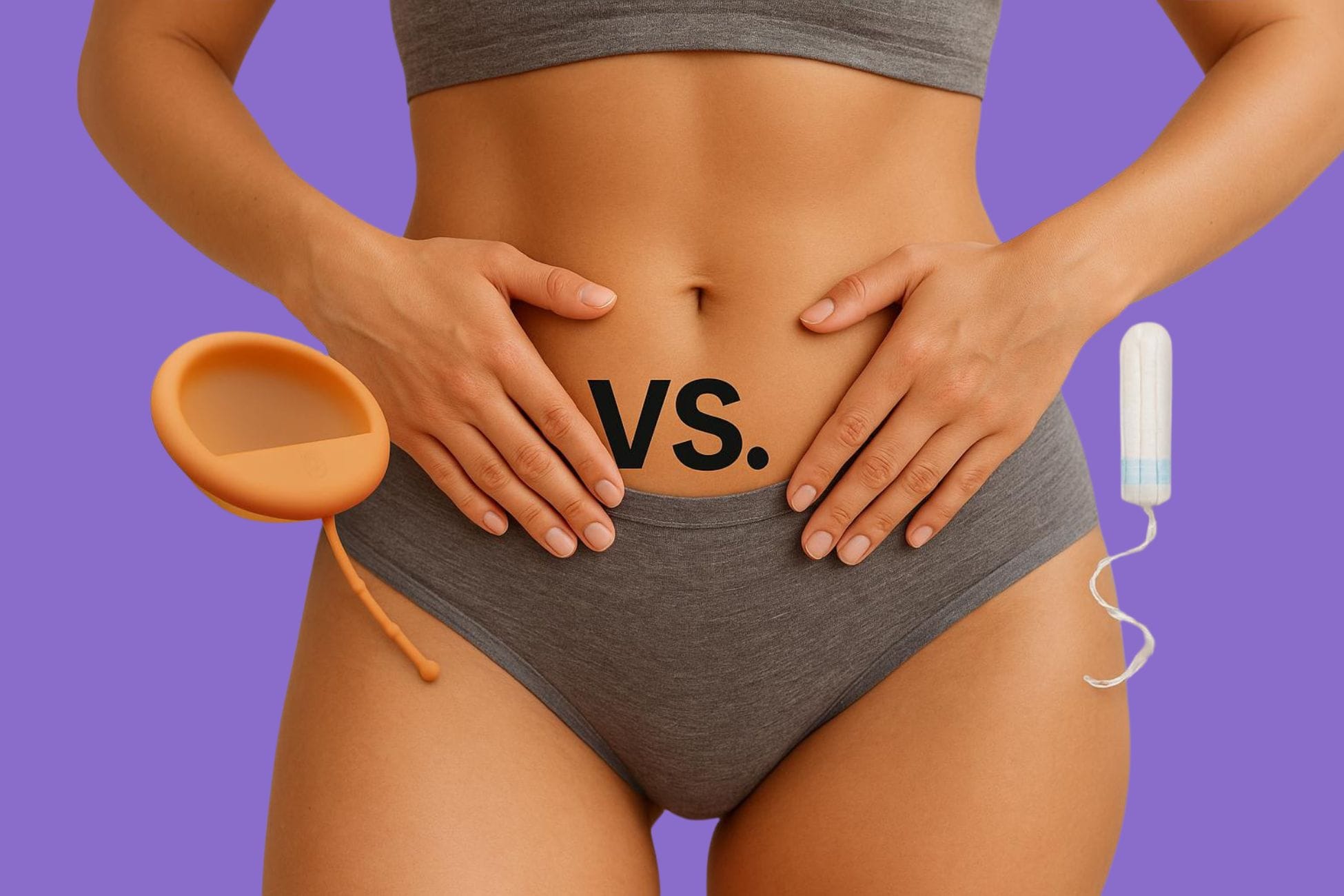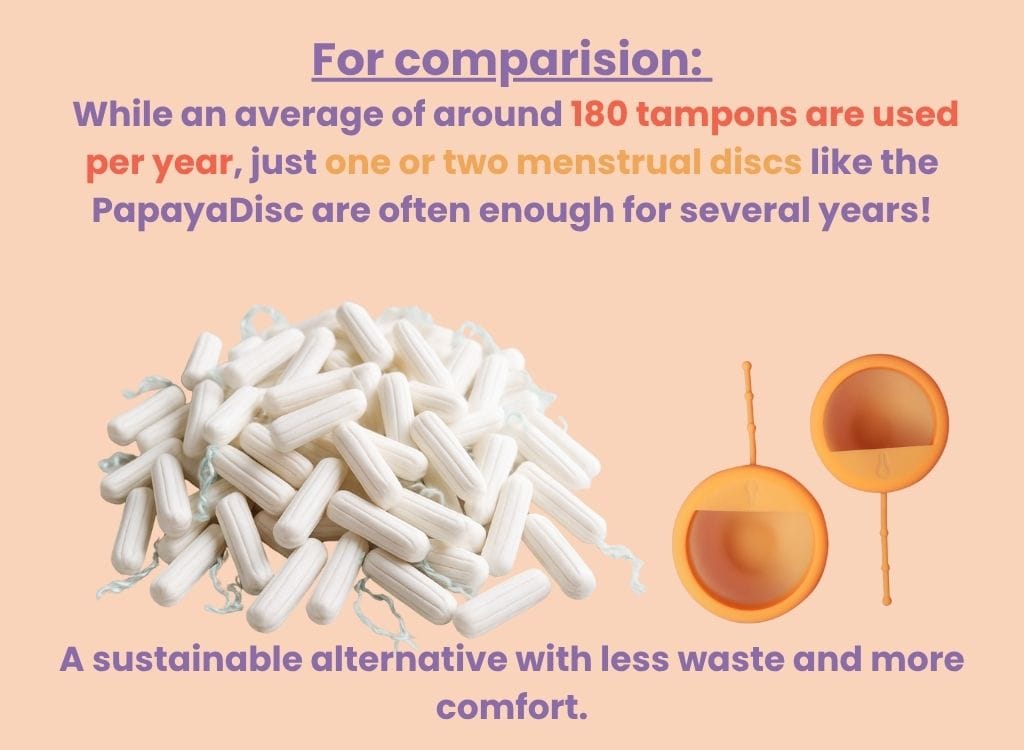
Insert the menstrual disc
11 de July de 2025
Understanding and easing menstrual pain – natural help for you
15 de August de 2025
Our menstrual disc comparison shows you everything you need to know about menstrual discs vs. tampons.
Inhaltsverzeichnis
- What is a tampon and how does it work?
- What is a menstrual disc and how does it work?
- The big comparison: menstrual disc vs. tampon
- Sustainability of menstrual products under the spotlight
- Menstrual disc or tampon? A decision guide based on lifestyle & personal needs
- You’re often on the go and need simple hygiene?
- You want zero waste and are looking for a sustainable solution?
- You’re active and play sports — even high-movement ones?
- You have sensitive mucous membranes or experience dryness?
- You’re new to menstruation or prefer not to feel anything?
- You need a quick backup or don’t have a way to clean properly?
- You want to sleep through the night without worrying about changing?
- Conclusion – menstrual disc comparison:
- Conclusion: two options – and plenty of good reasons
- FAQ: The 5 most important questions about menstrual discs compared to tampons
- Your next steps – we’re here if you have questions
Whether you're just starting to explore alternative menstrual products or simply curious about what's out there besides tampons — this menstrual disc comparison will help you get a clear picture.
We’ll show you how tampons and menstrual discs differ, what advantages each offers, and why sustainability is becoming an increasingly important factor in the world of menstrual products.
From comfort and safety to ease of use, choosing the right period solution is about finding what works best for your body, your routine, and your personal comfort — empowering you to manage your period with confidence.
Want to know how to insert a menstrual disc or how to use a menstrual disc properly? We've got you covered — plus, we’ll explain how to clean a menstrual disc so it stays safe and long-lasting.
What is a tampon and how does it work?
Structure and application
A tampon is a small, cylindrical product made of absorbent material that is inserted directly into the vagina during menstruation to absorb menstrual blood. Unlike a menstrual disc, it stays in the vaginal canal and absorbs the blood there instead of collecting it.
Using a tampon is simple: You insert it into the vagina with your finger or an applicator until it feels comfortable. A string remains outside the body, allowing you to remove it easily later on. Depending on your flow, you should change the tampon every 4 to 8 hours.
💡 Important: A tampon should never be worn for more than 8 hours to reduce the risk of toxic shock syndrome (TSS).
Tampons: overview of sizes and materials
Tampons come in different absorbency levels so you can choose what suits your menstrual flow best:
- Mini: for very light days or the start of your cycle
- Normal: for an average flow
- Super / Super Plus: for heavier bleeding
- Extra Super: for very heavy days (less common)
If you’re not yet sure which size is right for you, trial packs with multiple absorbency levels can help you find your personal favorite.
There are also differences in the materials:
Many tampons are made from 100% cotton, while others use synthetic fibers like viscose or polyester. Organic tampons rely on unbleached, chemical-free cotton — a great option for anyone who values skin compatibility and sustainability.
When buying tampons, it’s best to check the packaging carefully: you’ll find details about the materials used and any additives such as fragrances or bleaching agents.
What is a menstrual disc and how does it work?
Structure and application
Menstrual discs are flexible, flat-shaped cups that are inserted into the vagina during your period — but unlike tampons, they don’t sit in the vaginal canal. Instead, they’re positioned just below the cervix, where they collect menstrual blood rather than absorb it.
To insert the disc, you fold it in the middle (for example, like a taco) and slide it in at an upward angle toward the tailbone. Once inside, it unfolds on its own and naturally conforms to the shape of your vaginal canal. The front edge can gently tuck behind the pubic bone — keeping the disc securely in place.
What makes it special: menstrual discs don’t create suction like menstrual cups do, which can make insertion and wearing more comfortable for many users. Plus, the dryness that some people experience with tampons is avoided altogether.
Sizes and materials
Menstrual discs are typically made from medical-grade silicone, which is especially skin-friendly, flexible, and long-lasting. They are reusable and, with proper care, can last for several years.
Many models — like the PapayaDisc, for example — come in two sizes, allowing you to test which one fits your body best. A retrieval tab with textured grip elements makes removal easier, which is especially helpful for beginners.
Tip: For hygienic cleaning after your cycle, it’s recommended to sterilize the menstrual disc. PapayaCup offers a compatible sterilizer in their shop that’s easy to use in the microwave.
Key benefits at a glance
- Sits below the cervix – no vacuum seal
- Especially gentle on the skin and soft to wear
- No sensation of dryness
- Up to 12 hours of wear time
- Can be worn during sports, sleep, or even sex (depending on the model)
- Reusable and eco-friendly
The big comparison: menstrual disc vs. tampon
Still unsure whether a menstrual disc is right for you or if you’d rather stick with tampons? This overview shows you at a glance how the two menstrual products differ — from placement and wear time to sustainability and comfort.
Criteria | Menstrual Disc | Tampon |
Position in the body | Below the cervix | In the vaginal canal |
Capacity | Very high (up to 30 ml) | Low (approx. 6–18 ml depending on size) |
Wear time | Up to 12 hours | 4–8 hours |
Period sex | Possible (depending on the model, e.g. PapayaDisc) | Not possible |
Sustainability | Reusable, plastic-free | Disposable, often contains plastic |
Long-term cost | Higher initial cost, cheaper in the long run | Cheap per piece, more expensive over time |
Beginner-friendly | Requires a bit of practice to insert | Easier for beginners |
Wearing sensation | Barely noticeable, no vacuum sensation | Can feel dry or noticeable |
Sustainability of menstrual products under the spotlight
Environmental impact of tampons
Tampons are among the classic single-use menstrual products — and that’s their biggest drawback when it comes to sustainability. Multiple tampons end up in the trash each period, including individually wrapped plastic or cardboard applicators. Over the course of a year, this adds up to a considerable amount of packaging and residual waste.
What’s more: many conventional tampons contain synthetic fibers or microplastics — for example, in the outer layer or the string. Industrial cotton production also comes with a high environmental cost, requiring large amounts of water, pesticides, and energy.
Over a lifetime, a person who menstruates uses an average of 11,000 to 16,000 tampons — a number that highlights the significant environmental burden.
Environmental impact of menstrual discs
Menstrual discs like the PapayaDisc follow a completely different approach:reusability. Instead of using hundreds of tampons per year, one menstrual disc — with proper care — can last for several years.
This means you generate virtually no waste — fully in line with a zero waste lifestyle. No packaging waste, no disposables, no synthetic residues.
The math is simple: instead of using 11,000–16,000 tampons in a lifetime, you only need around 4 to 6 menstrual discs — a clear advantage for anyone looking to make mindful, resource-conscious choices.

Menstrual disc or tampon? A decision guide based on lifestyle & personal needs
Tampon or menstrual disc – which is the better choice? The good news: there’s no “right” or “wrong.” The decision depends entirely on your daily routine, body awareness, and personal preferences. To help you decide more easily, here are a few common scenarios:
You’re often on the go and need simple hygiene?
Both are suitable – with slight differences:
- Tampons are widely available, require no cleaning, and are easy to change – making them especially practical for travel, festivals, or spontaneous trips.
- Menstrual discs like the PapayaDisc can also be discreetly removed and inserted while out and about. The key is to have clean hands. For cleaning on the go, toilet paper or a small water bottle is usually enough — and at home, you can give it a thorough rinse or sterilize it.
You want zero waste and are looking for a sustainable solution?
Menstrual disc type:
If environmental friendliness matters to you, a reusable menstrual disc is the right choice. It lasts for several years, conserves resources, and drastically reduces waste. Instead of thousands of disposable products, you only need 1–2 discs.
You’re active and play sports — even high-movement ones?
Menstrual disc type:
Whether it’s strength training, dancing, or swimming — the disc sits securely below the cervix and adapts to your anatomy. No suction, no friction, and many don’t feel it at all during workouts. It’s also a great choice for longer training sessions.
You have sensitive mucous membranes or experience dryness?
Menstrual disc type:
Tampons don’t just absorb blood — they also absorb your body’s natural moisture, which can lead to dryness for some. Menstrual discs, on the other hand, only collect blood and help maintain your vaginal mucosa’s natural balance. A particularly comfortable option for sensitive bodies.
You’re new to menstruation or prefer not to feel anything?
It depends:
- Mini tampons are often an easy starting point because they’re slim and quick to insert.
- Menstrual discs like the PapayaDisc may take a bit of practice — but once in place, many users don’t feel them at all. A big plus: they can even be worn during sex (if the removal tab is trimmed).
You need a quick backup or don’t have a way to clean properly?
Tampon type:
In unplanned situations — like while traveling, on the go, or without a suitable storage case — a tampon can be a convenient choice. It’s ready to use, hygienically packaged, and available almost anywhere. Even if you don’t have clean hands or access to disinfectant, a tampon is often the quickest and easiest solution.
You want to sleep through the night without worrying about changing?
Menstrual disc type:
The PapayaDisc can be worn for up to 12 hours — perfect for restful nights or long days. Tampons, on the other hand, should be removed after no more than 8 hours to avoid potential health risks.
Conclusion – menstrual disc comparison:
What works best for you depends entirely on you — your priorities, your routine, your flow. Whether you choose a tampon or a menstrual disc, both options have their strengths. But if you're curious about a modern, sustainable alternative, the menstrual disc is definitely worth a closer look.
Conclusion: two options – and plenty of good reasons
Whether you choose tampons or a menstrual disc, both products have their place. What matters most isn’t which one is “better,” but which one suits you best.
Tampons are a reliable choice thanks to their simple use and wide availability — especially handy in spontaneous situations or when you need a quick solution. But the menstrual disc is also a practical companion on the go: it offers up to 12 hours of wear, takes up minimal space in your bag, and can be changed discreetly and hygienically — even while traveling or at a festival.
The menstrual disc also scores points for its sustainability, gentle feel without suction, and the satisfaction of reducing waste.
If you’re open to new solutions and value eco-friendliness, comfort, and flexibility, the PapayaDisc might be just what you’re looking for.
FAQ: The 5 most important questions about menstrual discs compared to tampons
A tampon sits in the vaginal canal and absorbs blood and moisture. The menstrual disc sits higher, directly under the cervix, and collects blood in a flexible bowl. This means no dryness and no vacuum, making it much more comfortable for many people.
Yes, absolutely. It is made of medical-grade silicone, is hypoallergenic, and is cleaned regularly and sterilized before each cycle. The only important thing: just like a tampon, it should not stay inside the body for longer than 8 to 12 hours.
If inserted correctly, it stays securely under the cervix and adapts to your anatomy. Leaks usually occur due to incorrect placement or the wrong size. Many models are available in S and L so you can test what suits you best.
That varies from person to person. Many find the menstrual disc gentler because it does not cause dryness or create pressure from a vacuum. Tampons can be more practical when you are on the go, as they are immediately ready to use.
It is ideal for you if you want a sustainable, soft period product, have sensitive mucous membranes, want more comfort at night, or need maximum freedom of movement during sports or even during sex. Tampons are better suited for spontaneous situations without the possibility of cleaning.
Your next steps – we’re here if you have questions
Curious to learn more? Here’s everything you need to take the next step with confidence:
🔍 PapayaDisc size guide – find the ideal size for your flow
🟣 Want all the details? The PapayaDisc Manual brings instructions, tips, and tricks together in one place
🔄 Comparison: Menstrual disc vs. menstrual cup – all differences and advantages at a glance
📚 How to use a menstrual disc – a clear step-by-step guide
Still unsure or have a question?
Just write to us at info@papayacup.com – we’ll be happy to help!



